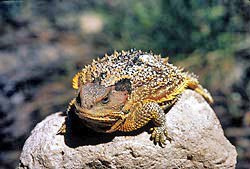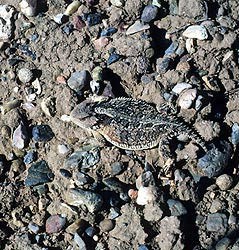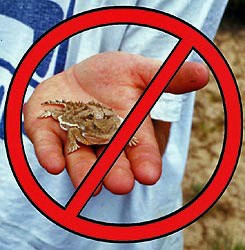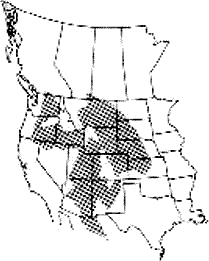|
Common Name: Short-horned Lizard Scientific Name: Phrynosoma hernandesi Size (length) English & Metric: 2 ½-5 7/8" (6.3-14.9cm) Habitat: From rocky or sandy plains to forested areas. Diet: Insects (primarily ants) Predators: coyotes, foxes, hawks, ravens, large snakes and lizards 
NPS Often called "horned toads," short-horned lizards are not toads, but flat-bodied lizards with short spines crowning the head. The trunk is fringed by one row of pointed scales, while the belly scales are smooth. The color is gray, yellowish, or reddish-brown, and there are two rows of large dark spots on the back. When threatened or aggressive, its' colors become more intense. The Mountain subspecies is primarily reddish with prominent horizontal spines, and ranges from southern Utah and western Colorado through Arizona, New Mexico, and Mexico. 
NPS Horned lizards take part in social activities, including fighting and mating. Courtship occurs between April and July. The short-horned lizard has live-birth litters of 6-31, typically born between July and August in the nests the mothers create. Babies are able to take care of themselves within a few hours but do not grow the horns on the head and back until later in life. The species is most active during midday and burrows at night. Only moving insects are seen as food, and sight of these will cause the lizard to become excited, follow after, and swallow the live insect. Horned lizards deal with predators by camouflaging themselves, hiding, fleeing, or as a last resort, attacking back. 
NPS Horned lizards are decreasing. Urban encroachment, radiation, and pesticides are among the factors hurting the species. Legislation has been enacted to prevent collection as pets in many states. As in all National Parks, the collecting of wild animals at Bryce Canyon is illegal. Monitoring and acting on recorded observations is crucial to survival of horned lizards. 
NPS Mountain Short-horned Lizards can be found throughout the summer both above and below the rim. They blend in so well to their natural surroundings, that you have to look close or you might not see them at all. Further Reading: Manaster, Jane, Horned Lizards, 1997: University of Texas Press, Austin. |
Last updated: October 12, 2021
